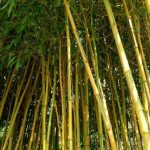 A group of woody evergreen plants in Gramineae/Poaceae; also the woody culm of such plants.
A group of woody evergreen plants in Gramineae/Poaceae; also the woody culm of such plants.
Considering its importance as both a foodstuff (in the form of bamboo shoots) and as a construction material (especially in Indonesia, where it has been used to make blinds, canes, water pipes, hats, ladders, scaffolds, kitchen pots, spears, paper, and much more), it’s surprising that little is known about the origin of the word bamboo. In English, the word appeared at the end of the sixteenth century, in a travelogue devoted to India. Earlier on, in Portuguese, the reed was called mambu, which may correspond to how the word was originally pronounced in Malay, Sundanese, or Javanese. It’s also unclear whether bamboo somehow inspired the invention of the word bamboozle, meaning to deceive, which appeared at the beginning of the eighteenth century. It might be conjectured that the nature of bamboo—sturdy on the outside but hollow inside—was taken as a metaphor for an empty promise.
A member of the tribe Bambuseae of the grass family (Poaceae), though used primarily for those species which produce substantial aerial stems, often rather woody and with lateral branches from the nodes. Bamboos grow from underground rhizomes that are long-running or short and crowded. The stems (culms) are hollow in most bamboos.
